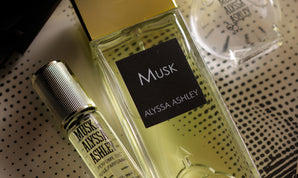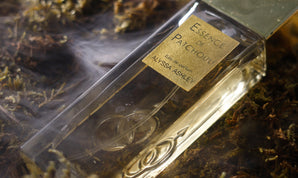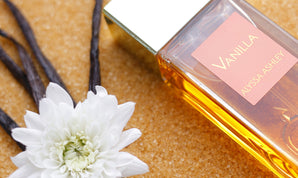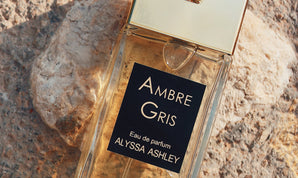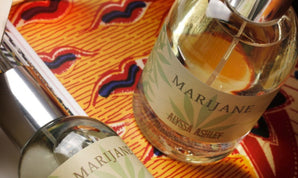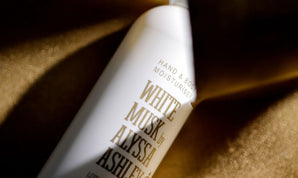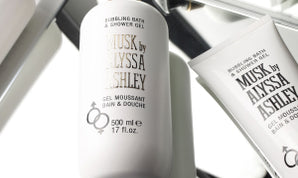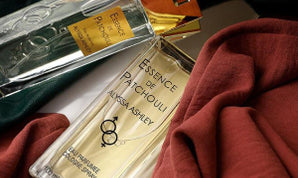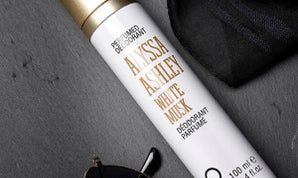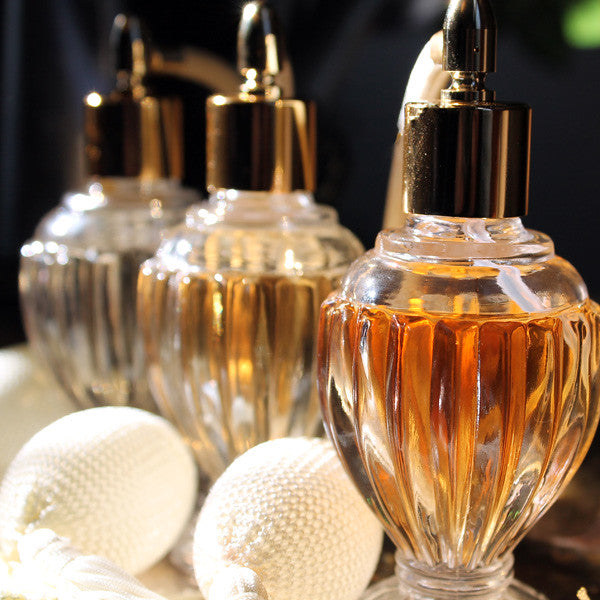- Eau de toilette vs eau de parfum vs extract vs cologne spray?
- What does eau de parfum mean?
- What does eau de toilette mean?
- The olfactory notes
When the United States began influencing the perfumery market in a significant way, some concentrates were introduced which ignored the rules that had always been used in the creation of perfumes. All this, on one side, allowed a positive expansion of the market to a clearly wider number of consumers, on the other side, however, it led to a distancing from the art of wearing perfume, with more and more people complaining about the lack of persistence of the fragrances they were buying.
This is because the volatility of a perfume is not only influenced by the type of essential oils that compose it, meaning that the top notes have a faster volatility than the base ones, and tend to disappear in the first few minutes or the first hour since the perfume is vaporized (The heart notes normally leave within four hours, leaving the base ones); however, the concentration of the fragrance in relation to the alcohol, which together make up our perfume, also determine the volatility of the raw materials.
This is the general rule: the alcohol inside in the formulation pushes the volatility of the perfume, therefore the greater the alcohol percentage, the lower the persistence over time.
Products on the market today are divided into four main categoriesdepending on the percentage of fragrance present compared to the other components of the perfume, (mainly water and alcohol): Extract, Eau de Parfum,Eau de Toiletteand Cologne Spray
Eau de toilette vs Eau de parfum vs Extract vs Perfumed water?
I am sure that most people think that the main difference between the categories indicated above is in the "power" of the perfume, perceived through its level of invasiveness, this begs the question:
Is eau de parfum or eau de toilette stronger?
So it is customary to believe that the extract is too strong, while the eau de Toilette is more delicate. But the truth is the opposite. The higher concentration of the extract makes some notes come out more delicately, giving a more rounded result to the composition; while the high concentration of alcohol in a product such as Eau de Toilette pushes the notes in a stronger way, which appears to be even stronger when vaporized, but disappears much faster.
To be classified as an extract, a product must have from 20% to 40% of fragrance within its formula. It is round and persistent. Only 20% of its composition will disappear in the first half hour from vaporization; another 30% will disappear during the following 4 hours and the remaining 50% will remain on our skin all day. It is the product with the highest quality in the perfumery. Unfortunately, the high concentration of fragrance means that it is more expensive than other compositions, therefore its use is not very common, and in the commercial world hardly any fragrances have the extract version. Well, we could say that this was caused by industry insiders, who have not been able to explain its quality.
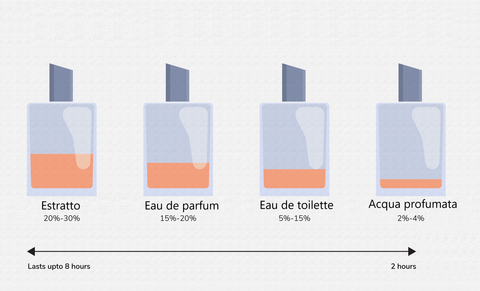
What does eau de parfum mean?
When we have 14 to 18% of fragrance we are dealing with the world of Eau de Parfum. This is certainly the most common version on the market. It is a good product in terms of olfactory result and product persistence. About 40% of the composition will evaporate within the first hour of vaporization, another 30% within the following four hours, and the remaining 30% will stay throughout the day.
From here onwards, we enter more commercial versions of perfumery products, whose advantageous price is justified by a lack of quality and durability.
From 8 to 12% we talk about Eau de Toilette.
What does eau de toilette mean?
In this case 50% of the olfactory power will disappear in the first hour after vaporization, another 30% after 4 hours and only 20% will stay all day. It is clear that the more our fragrance is rich in base essential oils, such as Patchouli, Amber or Musk, the less we will perceive this lack of power. But when we approach more perishable, green, aromatic or even floral fragrances, the olfactory result is obviously different. For perfume lovers, I recommend Eau de Toilette, to be sprayed several times a day, since they enjoy the process of applying the fragrance and constantly re-creating it.
Finally we have cologne spray. In this case the percentage of fragrance goes from 4 to 8%, the degree of volatility and persistence here is really low. Also because the percentage of alcohol in perfumed waters is lower than the water existing in the formula. Therefore the initial olfactory thrust guaranteed by alcohol is also reduced. It is certainly a light composition, good to use at the beach, when we wouldn’t normally wear perfume, or if we love to vaporize it all over the body, not only in strategic points
The olfactory notes
Before concluding, I would like to deny another belief regarding perfume. Very often when we talk about top notes, heart notes and base notes, we believe that these three parts of the perfume are separated from each other, and that the top notes appear first, then the heart ones, and finally the background ones. But it is not quite like that. When you spray the fragrance, all the different notes come out in harmony and harmoniously. As the top notes evaporate, we will only have a mix of heart and bottom notes. Only after several hours the heart notes will evaporate, leaving the base ones. So the only notes that can be perceived by themselves and not only harmonized with all the other notes, are the base ones, but I'll explain this in another moment!
WRITTEN BY ALYSSA ASHLEY’S EDITORIAL STAFF
